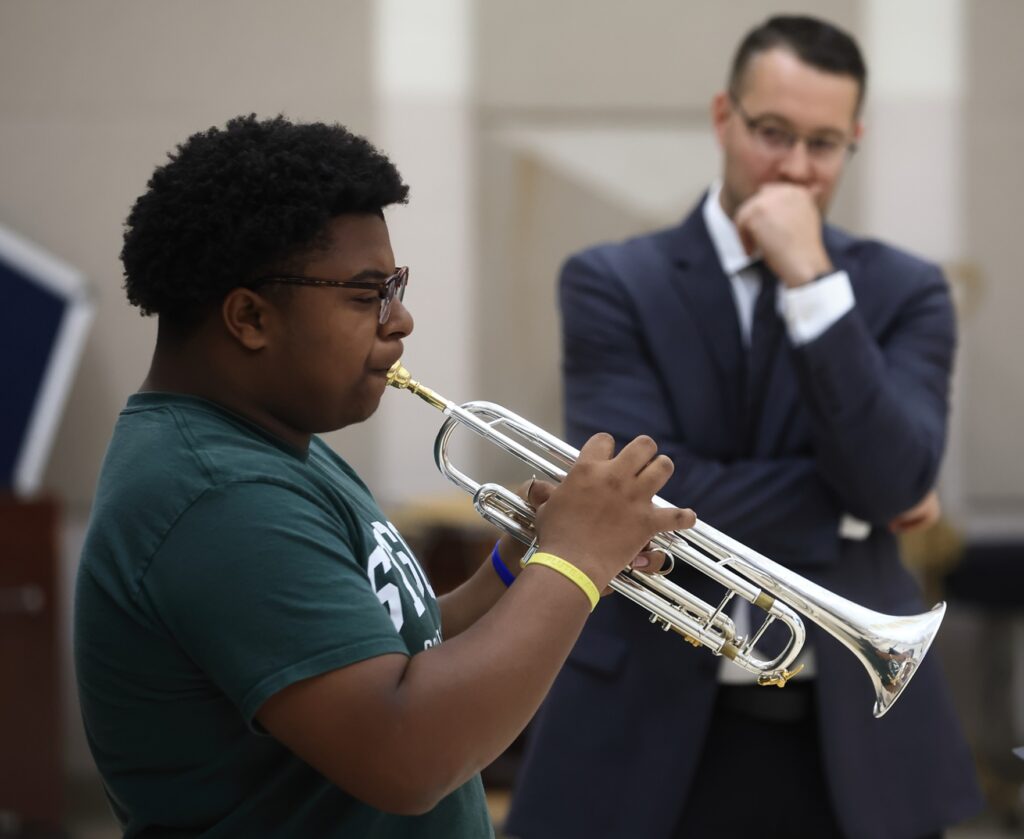The Harmony Director: A Great Tool for the Music Classroom
Achieve great sound, balance and tuning with the Yamaha HD-300.
When the Yamaha Harmony Director HD-300 was released, music educators were very excited because it was touted as a powerful tool to more effectively teach intonation and rhythmic training. With that excitement came many questions about how to incorporate the Harmony Director in daily rehearsals, such as:
- “Isn’t it just another keyboard?”
- “Do I have to be a theory geek to figure this out?”
- “How much time outside of rehearsal will I have to study to utilize it effectively?”
- “Isn’t it just a fancy F concert machine with a metronome?”
Any instrumental director can incorporate the HD-300 into their everyday rehearsals. The great thing about the Harmony Director is that you become more comfortable and proficient with the technology as you and your students learn together.
If you want to develop great sound, balance and tuning in your ensemble rehearsals, there is no device better than the HD-300 to help you achieve this. Tuning in a wind or string ensemble must include aspects of equal and pure (just) temperament. Using one or the other exclusively will not create the cohesive ensemble sound you desire. With a few simple exercises, you can begin to understand which temperament is appropriate at any given time.
THE YAMAHA EDUCATOR NEWSLETTER: Join to receive a round-up of our latest articles and programs!
What is Temperament?
Throughout music history, different tuning systems, or temperaments, were developed and improved as composers became more creative. Later compositions required musicians to be able to move freely from key center to key center, an impossible task in early temperaments.
For wind groups, the two most commonly used temperaments are equal temperament and pure (just) temperament. In order for wind groups to perform “in tune,” a combination of both equal and pure temperaments must be used.
Equal temperament is the standard tuning system used today. The idea of an octave split equally into 12 half steps is a common and obvious system to use. In the course of music history, however, it is a fairly modern concept.
Pure temperament involves the use of “pure 5ths” and “pure 3rds.” Pure intervals can be traced back to Pythagoras who used “perfect” mathematical ratios to create his tuning system. The use of these pure intervals gives major and minor triads a rich sonority that equal tempered 5ths and 3rds do not exhibit. The downside, however, is pure tempered chromatic pitches do not always sound sonorous with their neighbors. Essentially, tempering involves the slight adjustment of scale degrees to fix unpleasant sounding intervals within a scale.
The HD-300 has the ability to change its tuning from equal to either pure major or pure minor temperament. This allows the subtle differences in sound and tuning within those temperaments to be easily heard and demonstrated.
Which Temperament Should I Use?
In general, equal temperament should be used when working on scales, scale patterns or simple interval exercises like this “Remington” exercise. When you are tuning a melodic phrase or harmonic progression, it is best to use pure temperament.
Where Do I Start?
Start with the exercises that are a part of your daily basics routine.

Download Figure 1_Pure_Tone.
The exercise above is one of the most basic sound exercises because it helps create the reflex of a pure start, consistent middle and organized end to a sound. With the Harmony Director set to pure temperament, you can also accurately depict what the most prominent overtone sounds like. Set the HD-300 to pure F major, and it automatically adjusts the C concert +2 cents. This slight tempering of pitch places the C concert where it occurs naturally in the overtone series. This exercise can be quickly transferred to any key center just by the touch of a few keys on the Harmony Director.
The Next Step
When students become comfortable with hearing an adjusted perfect 5th, you may wish to move on to discussing tempering in a melodic phrase.

Download Figure 2_Pure_F_Major.
Begin by concentrating on the 3rd and 5th scale degree in a major key. This develops the basic concept and reinforces your initial discussion of temperament. In the exercise above, there are arrows above the flute part point up and down. In pure F major, the 3rd scale degree is adjusted -13.7 cents down from equal and the 5th scale degree is adjusted +2 cents up from equal.
Singing the exercise along with the HD-300 is an effective way to allow students to become accustomed to the adjustments. Do not get caught up in the math with the students. Use phrases such as “slight adjustment” (1 arrow) and “significant adjustment” (2 arrows). Try to avoid phrases like “play it slightly sharp” or “very flat”. Do not confuse tuning with a tuner and tempering with your ears. Encourage students to “let their ears guide them.”
Putting it Together!
Tempering is both a horizontal and vertical concept. By using a triad in any key, you can help students understand their role and how to adjust their pitch within a specific chord. The same concept applies here as it did in the melodic exercise. In pure F major students who play the 3rd would adjust down toward the root (-13.7 cents) and students who play the 5th would adjust slightly up away from the root. (+2 cents). Because the Harmony Director can switch quickly between equal and pure temperaments you can allow students to hear the “beats” of an unadjusted triad versus the clarity of an adjusted triad.

Download Figure 3_Basic_Chord_F_Major.
In all exercises involving the HD-300 and tempering, the most important tool students can use is their ears. Singing every exercise you play and every excerpt of music you perform is the quickest way to develop this skill in your students.
Going Further
As you become comfortable with simple exercises involving the Harmony Director and tempering, you will begin to see how it correlates with your concert literature. Find those places where you need to isolate specific chords or melodic content in a phrase and unlock the incredible power of the HD-300 and your student’s ears!
All exercise excerpts included in this article are from “Ensemble: An Integrated Approach to the Yamaha Harmony Director.” Contact Fannin Music Productions for more information.
















